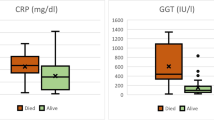Abstract
Background
Intra-abdominal abscess is a common complication of Crohn disease in children. Prior studies, primarily in adults, have shown that percutaneous abscess drainage is a safe and effective treatment for this condition; however, the data regarding this procedure and indications in pediatric patients is limited.
Objective
Our aim was to determine the success rate of percutaneous abscess drainage for abscesses related to Crohn disease in pediatric patients with a focus on treatment endpoints that are relevant in the era of biological medical therapy.
Materials and methods
We retrospectively reviewed 25 cases of patients ages ≤20 years with Crohn disease who underwent percutaneous abscess drainage. Technical success was defined as catheter placement within the abscess with reduction in abscess size on post-treatment imaging. Clinical success was defined as (1) no surgery within 1 year of drainage or (2) surgical resection following drainage with no residual abscess at surgery or on preoperative imaging. Multiple clinical parameters were analyzed for association with treatment success or failure.
Results
All cases were classified as technical successes. Nineteen cases were classified as clinical successes (76%), including 7 patients (28%) who required no surgery within 1 year of percutaneous drainage and 12 patients (48%) who had elective bowel resection within 1 year. There was a statistically significant association between resumption of immunosuppressive therapy within 8 weeks of drainage and both clinical success (P < 0.01) and avoidance of surgery after 1 year (P < 0.01).
Conclusion
Percutaneous abscess drainage is an effective treatment for Crohn disease-related abscesses in pediatric patients. Early resumption of immunosuppressive therapy is statistically associated with both clinical success and avoidance of bowel resection, suggesting a role for percutaneous drainage in facilitating prompt initiation of medical therapy and preventing surgical bowel resection.
Similar content being viewed by others
References
Kappelman MD, Rifas-Shiman SL, Kleinman K et al (2007) The prevalence and geographic distribution of Crohn’s disease and ulcerative colitis in the United States. Clin Gastroenterol Hepatol 5:1424–1429
Benchimol EI, Fortinsky KJ, Gozdyra P et al (2011) Epidemiology of pediatric inflammatory bowel disease: a systematic review of international trends. Inflamm Bowel Dis 17:423–439
Xavier RJ, Podolsky DK (2007) Unravelling the pathogenesis of inflammatory bowel disease. Nature 448:427–434
Baumgart DC, Sandborn WJ (2012) Crohn’s disease. Lancet 380:1590–1605
Van Limbergen J, Russell RK, Drummond HE et al (2008) Definition of phenotypic characteristics of childhood-onset inflammatory bowel disease. Gastroenterology 135:1114–1122
Vernier-Massouille G, Balde M, Salleron J et al (2008) Natural history of pediatric Crohn’s disease: a population-based cohort study. Gastroenterology 135:1106–1113
Fleshman JW (2008) Pyogenic complications of Crohn’s disease, evaluation, and management. J Gastrointest Surg 12:2160–2163
Richards RJ (2011) Management of abdominal and pelvic abscess in Crohn’s disease. World J Gastrointest Endosc 3:209–212
Larson DW, Pemberton JH (2004) Current concepts and controversies in surgery for IBD. Gastroenterology 126:1611–1619
Sahai A, Bélair M, Gianfelice D et al (1997) Percutaneous drainage of intra-abdominal abscesses in Crohn’s disease: short and long-term outcome. Am J Gastroenterol 92:275–278
Gervais DA, Hahn PF, O’Neill MJ et al (2002) Percutaneous abscess drainage in Crohn disease: technical success and short- and long-term outcomes during 14 years. Radiology 222:645–651
Rypens F, Dubois J, Garel L (2007) The place of interventional radiology in Crohn disease in children. Pediatr Radiol 37:1093–1095
Gutierrez A, Lee H, Sands BE (2006) Outcome of surgical versus percutaneous drainage of abdominal and pelvic abscesses in Crohn’s disease. Am J Gastroenterol 101:2283–2289
Rypens F, Dubois J, Garel L et al (2007) Percutaneous drainage of abdominal abscesses in pediatric Crohn’s disease. AJR Am J Roentgenol 188:579–585
Garcia JC, Persky SE, Bonis PA et al (2001) Abscesses in Crohn’s disease: outcome of medical versus surgical treatment. J Clin Gastroenterol 32:409–412
Golfieri R, Cappelli A, Giampalma E et al (2006) CT-guided percutaneous pelvic abscess drainage in Crohn’s disease. Tech Coloproctol 10:99–105
Dotson JL, Bashaw H, Nwomeh B et al (2015) Management of intra-abdominal abscesses in children with Crohn’s disease: a 12-year, retrospective single-center review. Inflamm Bowel Dis 21:1109–1114
Gee MS, Kim JY, Gervais DA et al (2010) Management of abdominal and pelvic abscesses that persist despite satisfactory percutaneous drainage catheter placement. AJR Am J Roentgenol 194:815–820
Levine A, Griffiths A, Markowitz J et al (2011) Pediatric modification of the Montreal classification for inflammatory bowel disease: the Paris classification. Inflamm Bowel Dis 17:1314–1321
Feagins LA, Holubar SD, Kane SV et al (2011) Current strategies in the management of intra-abdominal abscesses in Crohn’s disease. Clin Gastroenterol Hepatol 9:842–850
Author information
Authors and Affiliations
Corresponding author
Ethics declarations
Conflicts of interest
Dr. Peter Hahn reports the following finance interests: Stockholder, Abbott Laboratories; Stockholder, Covidien AG; Stockholder, CVS Caremark Corporation; Stockholder, Kimberly-Clark Corporation; Stockholder, Landauer, Inc. No conflicts of interest are reported by the other authors.
Rights and permissions
About this article
Cite this article
Pugmire, B.S., Gee, M.S., Kaplan, J.L. et al. Role of percutaneous abscess drainage in the management of young patients with Crohn disease. Pediatr Radiol 46, 653–659 (2016). https://doi.org/10.1007/s00247-015-3533-3
Received:
Revised:
Accepted:
Published:
Issue Date:
DOI: https://doi.org/10.1007/s00247-015-3533-3



